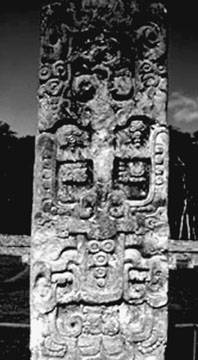

 | Page 671 |  |
and periodic conferences, IHAH has begun the development of standards crucial to coordinating research, which in recent decades has involved archaeologists from france, Germany, Great Britain, japan, Australia, canada, the United States, and Mexico and Hondurans trained in European, North American, and Latin American traditions.

Stele B from Copán
(Image Select)
References
Agurcia, R. 1984. “La defensa del patrimonio cultural en Honduras: El caso de la arqueología.” Yaxkin 7, no. 2: 83–96.
Veliz, V. 1983. “Síntesis histórica de la arqueología en Honduras.” Yaxkin 6, nos. 1–2: 1–8.
———. 1984. “La ley Patrimonio Cultural de la Nación.” Yaxkin 7, no. 2: 123–140.
The creation in La Spezia, Italy, in September 1864 of the Congres Paleoethnologique International (CPI) during a meeting of the Societa Italiana di Scienze Naturali marks the de facto beginnings of the International Union of Prehistoric and Protohistoric Sciences. In 1867, the CPI changed its name to Congres International d’Anthropologie et d’Archéologie Prehistoriques (CIAAP), and that organization can be described as the direct ancestor of the contemporary union. The origins of the present organization therefore go back some 130 years. The prime movers in this international initiative were Giovanni Capellini (president of Societa Italiana di Scienze Naturali) and the French archaeologist gabriel de mortillet.
Between 1866 and 1912, fourteen international congresses were organized (a Permanent Council was created during the Lisbon session of the CIAAP in 1880), but World War I put a stop to these fruitful and constructive meetings. The Institut International d’Anthropologie (IIA), founded in 1921 after the war, tried to bring archaeologists and anthropologists together again, but this group was almost totally French inspired and dominated (all five members of the executive committee were French). It was also totally different from the CIAAP in two essential ways: its main emphasis was on “anthropology” in its widest sense (as the study of living human communities, comparative religion, folklore, etc.), with prehistoric archaeology forming a smaller section than had previously been the case; and scholars belonging to the “vanquished nations” were excluded from the activities of the IIA. For both of these reasons, numerous prehistorians and anthropologists did not choose to join or belong to the IIA, and several (such as marcellin boule, R. Verneau, hugo obermaier, and P. Bosch-Gimpera) tried to continue the real international tradition of the prewar CIAAP.
After several efforts at collaboration between members of the Permanent Council of the CIAAP and the Executive Committee of the IIA, it was finally decided that the fifteenth session of the CIAAP and the fourth session of the
 |  |